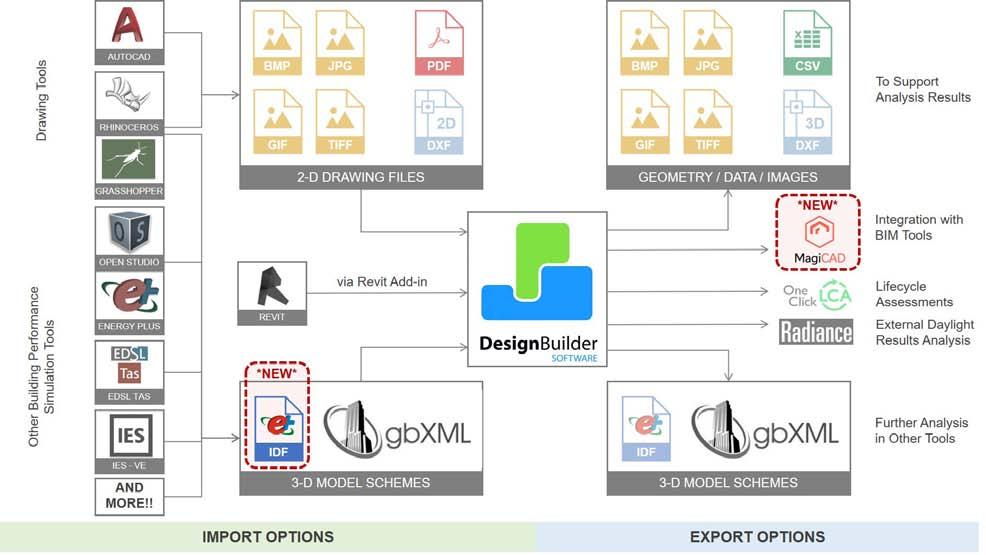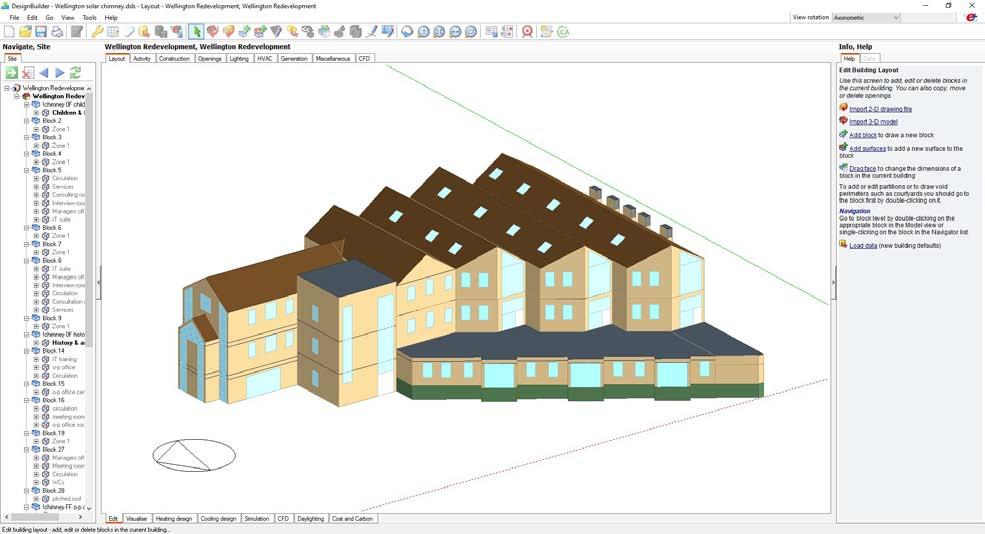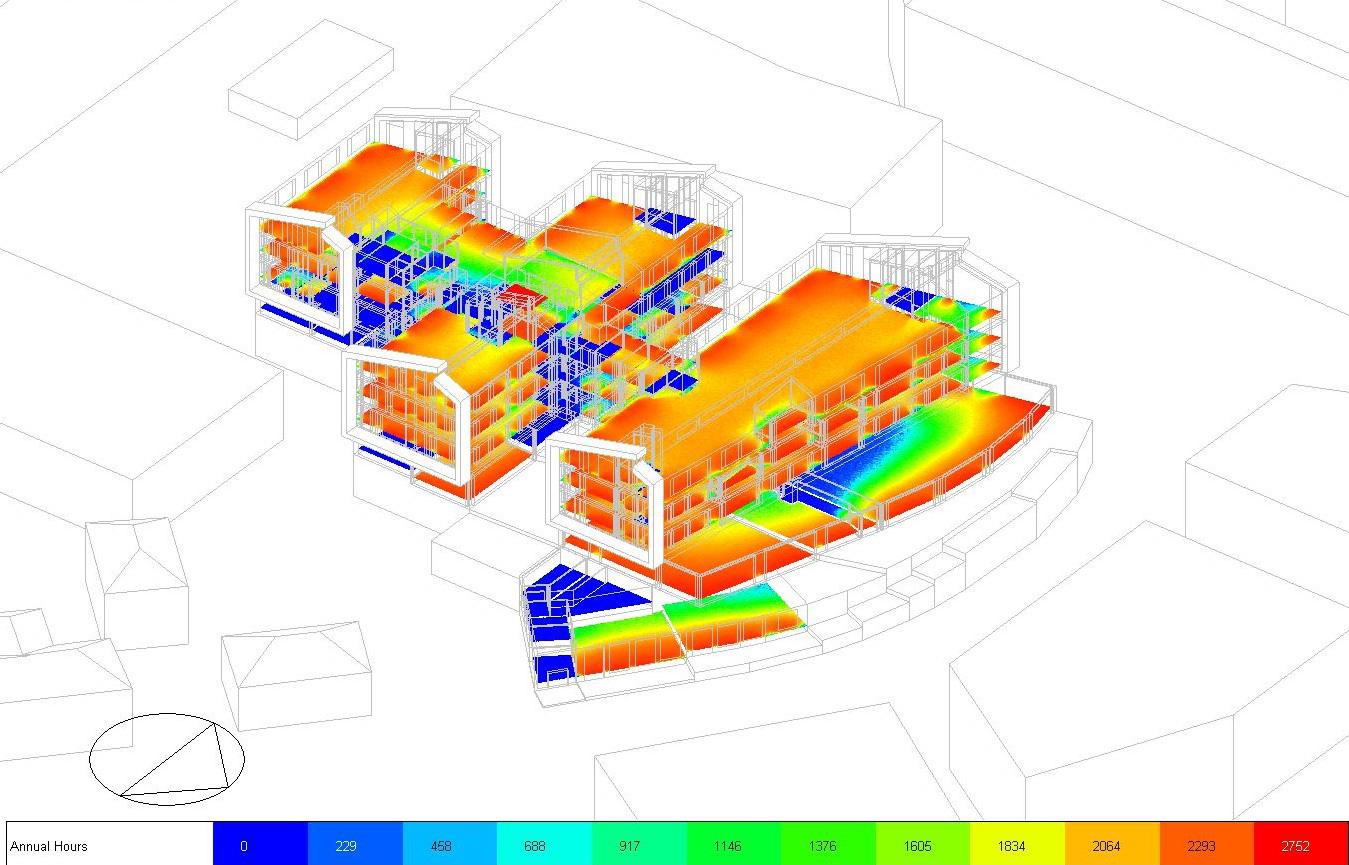
4 minute read
DesignBuilder v7.0 is here
from IBPSA News 31-1
by hopfe
DesignBuilder v7.0 is here!
DesignBuilder Version 7 is now available, adding powerful new features that both extend DesignBuilder’s capabilities and improve modelling workflow and productivity. The main new v7 features and improvements are summarised below.
Advertisement
Simulation Engine and User Interface
Full 2D/3D Kiva ground modelling for better assessment of surface temperatures
The modeller and visualisation tools sit at the heart of the DesignBuilder workflow, and v7 includes some significant improvements in this area with several new functionality improvements and data management tools enhanced:
n DesignBuilder is the most capable and mature graphical user interface for
EnergyPlus v7 includes the latest EnergyPlus v9.4 and the performance and feature enhancements that brings.
n The Model data grid tool has been updated to allow HVAC data to be read and edited in a data grid form. The model data grid view data management tool enables you to define your own data views, optionally export the data to spreadsheet, modify it and then import it back to your DesignBuilder model.
The tool is ideal for fast bulk editing of data and QA processes.
n A new ‘Follow Path’ tool is included to help generate complex block shapes, building on the capabilities already provided by our ‘stretch’, ‘drag face’, and
‘add surface’ tools.
n DesignBuilder v7 comes with Full Kiva ground modelling for more accurate building-ground heat transfer calculations. Kiva is a validated state of the art ground modelling component used by EnergyPlus to calculate key 2D ground temperature profiles through the 3D ground domain at runtime. These profiles
connect with the building ground adjacent surfaces to improve the accuracy of the ground heat transfer calculations. Only a small amount of extra data is required to drive Kiva and there is little noticeable effect on simulation times.
Unlike the constant temperature approach used in most energy models, it is not necessary to enter ground temperature data, which is rarely (if ever) available in practice. Instead, deep ground temperatures calculated from the hourly weather data are used as the lower boundary condition in the simulations. There is even a “Kiva Basic” option which provides the extra accuracy but with only a few additional input parameters.

A wide range of interoperability options provided by DesignBuilder.
n The core concept of DesignBuilder is different to other “mainstream” commercial simulation tools. DesignBuilder is an interface that makes using the best available open-source engines (EnergyPlus, Radiance and soon OpenFOAM) as fast and easy as possible. As our industry continues to develop fantastic tools with new capabilities, being able to transfer data between tools without having to rebuild entire models is becoming increasingly important.
DesignBuilder provides multiple import and export options in a variety of formats to maximise interoperability with other tools, and v7 adds two new interoperability options: importing EnergyPlus IDF files and direct export to MagiCAD to provide HVAC loads data for use with BIM tools including Revit.
n And finally, new display colour themes have been added so you can select from one of the refreshed looks supplied with the software… or you can create your own custom theme.

One of the new customisable User Interface colour themes
Enhanced Extensibility

DesignBuilder extensibility tools and their links to API and other modules
DesignBuilder has always provided a relatively open platform with full access to simulation inputs, outputs, EMS runtime scripting tools and EnergyPlus source code. Our latest Python and C# scripting tools enable simulation inputs and outputs to be further processed before and after simulations. The API and Python scripting tools, released in the last version have now been significantly improved by:
n Python scripting access to our API to enable plugins and scripts for an unlimited range of custom calculations, reports and model processing by users and 3rd party developers. n Linking scripting to DesignBuilder Parametric analysis tools including optimisation, parametric and uncertainty and sensitivity analysis. This link enables use of any input parameter as a design variable and any EnergyPlus
output or custom calculated output as a KPI. This opens opportunities for users to use DesignBuilder’s optimisation engine to automatically search for the best solutions to meet performance targets and compliance requirements.
Daylighting
DesignBuilder v7 includes a major upgrade of our daylighting tools. The most important new daylighting features included with v7.0 are:
n Climate Based Daylight Modelling (CBDM) simulations are now run directly in Radiance replacing our previous Daysim implementation. As part of that dynamic blinds are simulated as specified in LM-83-12 for sDA 300/50 calculations.
n A report is provided for the BREEAM HEA 01 Option b annual daylighting credits.
n Translucent Component blocks can now be simulated in daylighting simulations making it easier to accurately include objects such as trees in your model.
n Daylight distribution maps are now displayed in the modeller with options for numeric labels to be displayed in each cell and for colour palettes to be used.
The new display helps make the context of the daylighting results clearer and your reports more impactful.

Daylight results in 3D view
LEED/ASHRAE 90.1
DesignBuilder V7 supports ASHRAE 90.1 App G 2013 and 2016 modelling including the latest baseline HVAC systems. Also, you can now generate the LEED v4 Minimum Energy Performance Calculator reports directly from DesignBuilder with all the key data items filled out.










